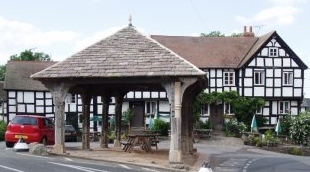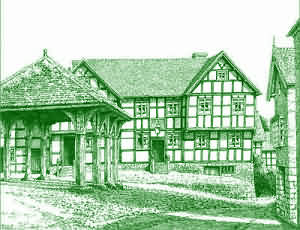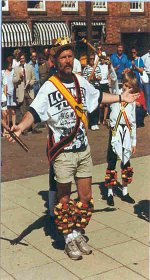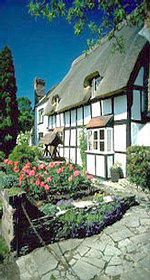
The Local Time is Saturday, 27-Jul-2024 11:03:36 CEST
Black and White Buildings in the County of Herefordshire |
|
|||
| YOU ARE HERE: Main Home Page > Herefordshire > Black and White Buildings |
|
|
 |
|
Tour and Tourist Information Guide for
|
|||||
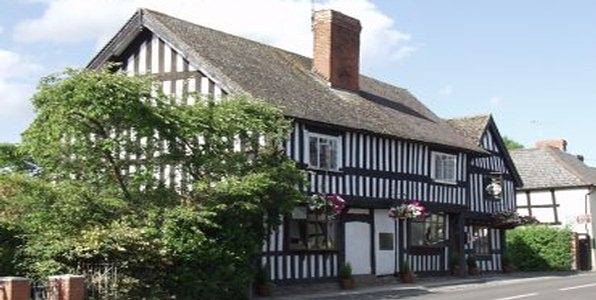 |
|||||
The Best of Black-and-White The official Trail is a 40-mile journey around these Herefordshire Villages Eardisland - Award-winning "Prettiest Village" The trail, as the name suggests, is characterised by the large number of timbered and half-timbered houses in the area some dating from mediaeval times, others from more recent periods. Eardisland is about 6 miles due west of Leominster and the bridge in the background carries the B4529 road to Leominster over the river. Drive, Walk, Cycle, or Stay and Eat Following the black and white villages trail in North Herefordshire is a highlight of a Herefordshire Holiday: each village is a treasure trove of cottages, inns and shops all constructed with timber framing so characteristic of this wood-rich area.
Black and White hostelries throughout the country invite you to stay and eat. Many of the houses in Herefordshire date from the 16th and 17th century or earlier, when timbers were often left unpainted to weather naturally,while the panels were painted with pigmented lime wash. The framework was built from green (Unseasoned) oak and the panels are in-filled with lath woven strips of wood and plaster. The idea of decorating timber framed houses by painting the beams black and the panels white is a recent one.
The name Weobley, pronounced Webley, derives from Wibba's Ley (Ley is a meadow) and is listed in the Doomsday Book as 'Wibelai'. Pembridge is about 3 miles due west of Eardisland and, like Eardisland, is also on the River Arrow. A Then and Now image of Bell Square in Weobley. Refresh the page to view.
A view and drawing of Pembridge Market House, now and then.
|
|||||
|
|||||
|
According to local news, THE tomb of John Abel - the King's Carpenter from Herefordshire - is to be restored more than 300 years after he built it. A campaign was started in 2001 to revitalise the memorial, which marks the final resting place of a master craftsman whose name is synonymous with some of the county's finest timber-framed buildings. John Abel was laid to rest in 1674 in St Mary's Church, Sarnesfield, the memorial features a barely legible epitaph that the great carpenter wrote before his death. The tomb, which stands near the church's porch, was restored in Victorian times by the National Society for Preserving the Memorials of the Dead, but the ravages of time have caught up with it again. His reputation as a carpenter of the highest order spread far and wide, but the man himself never wandered further than Brecon. Born in 1577, one of his first commissions was to provide a new roof for Vowchurch Church in 1613. He built the Town Hall at Brecon in 1624 and 10 years later the Market Hall at Leominster. On August 20 1625 Abel signed a contract to build Lady Hawkins' Grammar School at Kington, for which he was to receive £240. All that survives today are some ceiling beams and a window. His fame was taken a stage further in 1633, when he signed a contract for the rebuilding and repair of Dore Abbey. A century of indifference over the fate of this Cistercian monastery had left it in a sorry state, but Abel was more than up to the challenge - finding, felling and using the timber all in five months. In 1634 he built the splendid Leominster Town Hall, which stood as a testament to Abel's expertise for 222 years. In 1855 the town council took it down and offered it for sale. It aroused little interest and was sold for £95. Then the MP for Leominster, John Arkwright, bought it for the same sum and offered it back to the council if it would agree to re-erect it. They refused, however, and it was eventually re-built as a private house, known as The Grange, on a site near the Priory Church. It remained privately owned until the 1930s, when a more caring council, alert to the possibility of it being sold to America, bought it for £3,000 and today remains a source of civic pride in Leominster. The honour of King's Carpenter was bestowed on Abel for his efforts in 1645 when the Scots laid siege to the city of Hereford, which was defended by Barnabas Scudamore? The Scots had succeeded in destroying the powder mill on which the garrison depended for ammunition. But Abel's ingenuity in making hand mills saved the day - Hereford was able to hold out and the King himself raised the siege by riding into the city. Other notable buildings constructed by Abel included the timber-framed market hall in Kington, which was taken down in 1820 and replaced. Then came Monnington Court, which still stands today, and the rebuilding of Brampton Bryan church in 1656. His name is also linked to many other county buildings, including the Old House in Hereford and the city's magnificent town hall, demolished in 1862. However, there is no conclusive proof that he had a hand in either. In his lifetime, John Abel was associated with buildings in: Kington, Weobley, Vowchurch, Abbeydore, Tyberton, Monnington-on-Wye, Stretford, Orleton, Pembridge, Ross-on-Wye, Ledbury, Leominster and Hereford. |
|||||
|
|||||
| BACK TO TOP | |||||
Black and White Buildings in the County of Herefordshire |
|||||
| This page last modified Tuesday, 28-May-2019 10:59:31 CEST | |||||
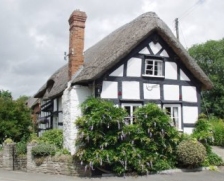 Eardisland grew around a castle which has long since vanished although the great moated mound where the castle once stood can still be seen. The castle was built to guard the road between England and Wales where it crosses the River Arrow.The oldest houses in Eardisland date from the 14th Century.
Eardisland grew around a castle which has long since vanished although the great moated mound where the castle once stood can still be seen. The castle was built to guard the road between England and Wales where it crosses the River Arrow.The oldest houses in Eardisland date from the 14th Century.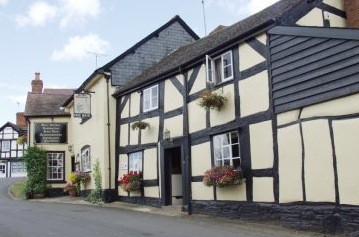 At the centre of each village is a fascinating church, as varied as the ancient black and white buildings grouped around them.
At the centre of each village is a fascinating church, as varied as the ancient black and white buildings grouped around them.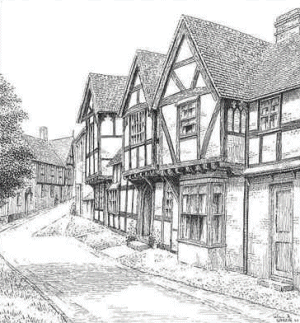 Weobley is about 10 miles south-west of
Weobley is about 10 miles south-west of 